#its particularly bad with the heralds
Text
My Hot Take Of The Day is that a lot of people see the Seeds as how they see/portray themselves and not as how they actually are
#i hope this makes sense#its particularly bad with the heralds#a lot of portrayals i see of the heralds in fanart and fanfic is accurate in the sense that it IS how they portray themselves in game-#-towards others and the deputy#but its not how they actually ARE which we are given glimpses of both in the main game AND through the collapse dlc#maybe i will expand on this later if i can manage to put the words together#all im saying is that they would be really flattered seeing their ideal selves in your fan content rather than who they actually are lol
2 notes
·
View notes
Text
AFO’s last words to Yoichi are great inspiration for what I’m already doing with his character in my fanfic ‘Urges’.
I went ahead and got this out of my head and felt I would share it with you all. This is the beginning of AFO’s POV in the 2nd chapter. The only difficult thing is that I decided to not give AFO a name in this fic, so I have to be careful to make sure readers understand who is talking and acting. Of course, I may introduce a name he gave himself for other people to call him, but I think it’s extra weird that he only wants Yoichi to call him Big Brother/Brother.
To read the first chapter, click here.
—————
Late.
He hated when Yoichi was late.
The world outside their nice apartment may be rebuilding, but it still was nowhere near safe enough for his precious Yoichi. Small and frail as a result of the syndrome they experienced in the womb, his little brother was a prime target for those unbothered by the reconstruction efforts of the populace.
Yoichi has always been a positive boon to their lives. Even when they were barely making it on the streets of a derelict society. Somehow, his little twin always found beauty in the dank corners of alleyways, and held an innocent, ignorant belief in the good inside the pathetic people around them. The individuals that scurried around like the rats the brothers had begrudgingly accepted as housemates.
As obnoxious as it could be, he cherished those memories of Yoichi’s optimism.
One such recollection always brought a nostalgic smile to his face.
It had been a particularly bad winter for the region. Luckily, he had come upon a most needed meta ability involving fire. It was nothing spectacular, only good enough for a small flicker, barely able to light a insignificant pile of trash. There was plenty of litter in the large, overturned dumpster he had found hidden down a long alleyway. Holes in its rusted exterior allowed venting of the smoke and the brothers had enjoyed cooked vermin as sustenance.
It was a delicious upgrade compared to their usual consumption of the rodents raw. His earliest memories involved catching them. As a baby already capable of crawling, it had been up to him to use the spike meta power he had always had to skewer the rats. He would then use the same power as teeth to mush up their bodies and bring the food to his frail, underdeveloped twin. Spitting up the pile in front of Yoichi, he would guide his mouth to the chewed up meat and pat his twin’s head as he eagerly consumed the slop.
The larger twin had fallen asleep late the night prior, but awoke with a start at the dinging sound of rain upon the decaying metal of their humble home, his arms empty of the person he normally awoke next to.
Yoichi was gone.
In a frenzy, he irrationally dug through trash in the dumpster to find him. With no luck, he had scurried out into the alley, whipping his head to and fro, scanning the lane for a mop of white hair. The atmosphere was muggy, even the young boy could feel the start of spring herald by a thread of warmth amongst the fall of water.
Then he finally found him.
Yoichi stood in the middle of the open street beyond their alleyway home. The older one’s building anger was extinguished as the melodic giggles of his small twin reached his ears. As he moved closer, he could clearly see Yoichi’s hands outstretched towards the overcast sky, his gleeful laughter starting and stopping as he filled his mouth with the naturally filtered water.
“Yoichi! What?” Their vocabulary was small and raw like the meat he used to dine on, but enough for the tiny twin to be momentarily startled out of his merriment. His visage quickly changed back to one of pure joy.
“Brother! Wet! Good!” Yoichi clapped his hands then signaled for his older brother to come closer.
Unlike his twin, the eldest was on constant alert. Once one foot stepped out from the safety of their side street, he immediately scanned the open area for potential threats, eyes wide like a prey animal.
Yoichi grabbed his hand and pulled him out with him, pointing at the sky and smiling at his large brother. That smile. Wide and toothy. Filled with such wonder and naivety. One of the few things in this terrible existence that warmed him regardless of the season or the chill in the air.
“Brother! It pretty! Pretty! Watch!” Yoichi raised one hand to the sky now, his other clasped in his brother’s hand.
But he didn’t watch the sky nor the rain. His eyes were trained only on his precious twin.
“Yes. Pretty,” he whispered as he continued to gaze upon him though the other’s eyes were entranced by the shimmering drops. He allowed his twin to look at something other than himself. Maybe just this once.
Yes. His precious Yoichi is so pretty.
#all for one#afo#yoichi shigaraki#my hero academia#boku no hero academia#bnha afo#bnha yoichi#mha fanfiction#bnha fanfiction#fanfiction#my writing#mha snippet#bnha snippet
35 notes
·
View notes
Text
Herald of Abadar: Lawgiver
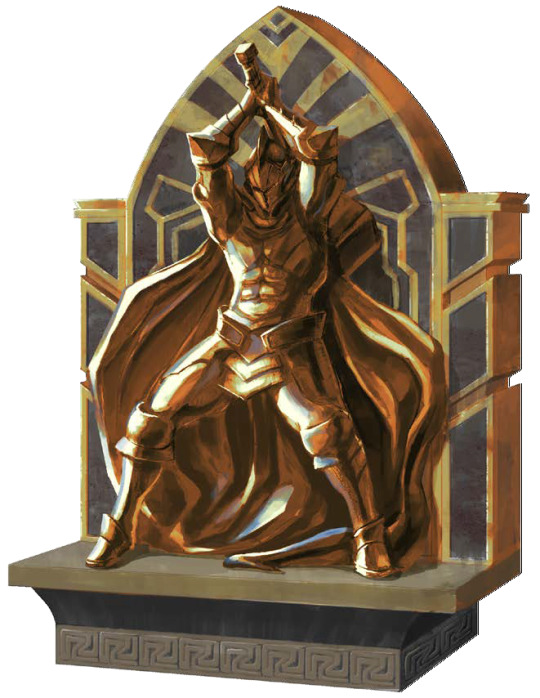
CR 15
Lawful Neutral Gargantuan Construct
Inner Sea Gods, pg. 276
Well, I suppose we have to get this guy out of the way at some point, so why not put him at the start of Monitors and Misfits Month? It's especially fitting considering Abadar is the first core god that most people will see in just about every list of deities thanks to his name! The God of Civilization has done a lot for the mortal world and for the Perfect City of Axis alike, with the implacable Lawgiver being one of his simpler creations, made to enforce the peace of Axis and to act as Abadar's strongarm in the mortal world. Much like its fellow "boringly-named Construct in service to a Lawful god crafted for the express purpose of combat" the Grand Defender, the Lawgiver was not born, but made, crafted directly from the metals of Axis to serve as its defender and to hit Chaotic creatures with a huge hammer. It's got a lot in common with the GD!
Including being very boring. If you put the Hand of the Inheritor on one side of a Venn diagram and the Grand Defender on the other, the Lawgiver would be dead in the center right under the topic of 'statistically boring.' This isn't to say it's weak, far from it! But the Lawgiver is as every bit as stuffy, practical, and to-the-point as its creator, eschewing having any unique abilities or equipment or any bombastic spells in favor of a handful of generically useful spells and the aforementioned hammer. It doesn't even have an interesting personality, the book outright noting the thing almost never speaks, and when it does it's almost entirely passages from Abadar's holy books and manuals which are relevant to the current situation.
You can, perhaps, sense my frustration with and boredom towards Lawgiver here, a feeling that appears to be shared with the staff of Archives of Nethys, who haven't updated its statblock since its original release in Curse of the Crimson Throne: Seven Days to the Grave back in 2008, forcing me to keep Inner Sea Gods open in my other hand to make sure my data is accurate. As you may expect from such a forgettable entity, this won't be a particularly interesting article, but it is one that must be written to set the stage for the rest of the Heralds this month. So, let's take a look at the Big Man With A Hammer which, as we'll find out, is all it needs to smash most proteans and demons to paste.
Let's get the big hammer out of the way, first. The guy is stanced up in his picture for a reason! He's winding up for a big, two-handed slam with a +1 Axiomatic Warhammer sized for a Gargantuan creature, the heavy weapon dealing 4d6+10 (+2d6 vs Chaotic) damage upwards to four times a round and triple damage on a critical hit. Should it prize power over accuracy, the Lawgiver can use Power Attack to take a -4 penalty to its attack rolls for +8 to the damage, a trade it will typically make without hesitation against Chaotic Outsiders.
With a 20ft space and 20ft reach, Lawgiver shrouds entire battlefields in its threat radius, being one of the largest Heralds yet one of the few who can take its foes by surprise; it's not only capable of freezing completely stock-still and pretending to be a statue, but it can freely Change Shape into a large eagle to scout or hide from prying eyes, typically doing so when patrolling Axis to keep an eye out for trouble. It can also be considerably less subtle by turning into a two-headed golden eagle, which most sane beings would recognize as an omen that something very bad was about to happen to them if they don't turn and leave.
Even in its natural statue state the Lawgiver can fly 60ft a round, letting it get really goofy with its Full-Attacks if it wants, slamming its hammer down on its enemies from above while they're stuck on the ground, Medium-sized foes unable to fly made completely worthless by its superior reach... though this is used more often to catch up to flying enemies than it is to let it safely attack ground-bound foes, because every protean flies and they're by far Axis' most common enemy. And if someone's got magical flight to keep up with it, it really has nothing to say to that.
It's got a huge pile of spell-likes, more than almost any other Herald, but they're all for the good of the people of Axis and the mortals fighting alongside the Lawgiver than for the Herald itself. Just take a look at the healthcare you get on Axis' battlefield: Cure Serious Wounds, Neutralize Poison, Remove Blindness/Deafness, Remove Curse, Remove Disease, and finally Remove Paralysis, ALL of these spells usable 3/day! Paizo should have saved time and just given it Heal and Greater Restoration; mostly the same effect, less text.
You'll notice that every single one of those spells is useless to the Lawgiver, who--as a Construct--is immune to basically anything but HP damage. That spell list is exclusively for the mortals fighting alongside it and citizens harmed in the crossfires of the war on chaos! And speaking of Construct defenses, the Lawgiver is a fairly sturdy robot, all things considered: 34 AC, immunity to Acid and Electricity, 10 Cold and Fire Resistance, and 26 Spell Resistance overall. It's also got All-Around Vision to deny flanking bonuses and is immune to critical hits, and uniquely is also impervious to rust, something I assume many proteans hoping to erode the city of Axis found out all too late.
It's a pretty sturdy robot! Even if it is undecorated. Function over form, and all that; Abadar knew what he wanted when he built it, and it's no more than that. And that's more or less it!
You can sort of read more about it here; you'll need to use the d20pfsrd version to actually see its updated stats.
14 notes
·
View notes
Text
I've seen it said on occasion that it was a refreshing change to have the Inquisitor be unable to persuade and change the minds of the characters around them, that the characters felt "more real" that a brief conversation shouldn't change their entire worldview.
This is bull.
First of all, no one asked for their entire worldview to change, just that they GIVE a little - argue with Vivienne about the merits of mage freedom, be able to point out that fear is learned as much as anything, that the fear of mages has been taught because mages are not allowed to be part of the world that the common folk experience, or even that her view of magic is not shared BECAUSE it comes from so lofty a position in society, as she is a First Enchanter, leader of the Loyalists, mistress to the head of the Council of Heralds. Or, here's one of my personal favorites, the vote to break away from the Circles may have passed by a narrow margin, but it still PASSED, and if Fiona had refused to accept that, she'd have faced a hundred minor revolts instead of a singular organized one, which would have meant that the few who went around, burniating the countryside, would be seen as representative of them all, while have an organized structure to the rebellion allowed them the ability to disavow bad actors.
It's asking Sera to acknowledge that there's more nuance than her definitions of the world offer, or countering to Cassandra that, particularly if she intends to take a position of top authority in the Chantry, she needs to be able to look beyond its dogma and realize that to those who follow a separate faith, the Chant of Light is a herald of death, an omen of doom, because it refuses to allow any who follow a separate faith. It's telling Solas that the Dalish have been forced to build their history from tattered scraps, and rather than condemn them for what they lack, he should acknowledge and appreciate what they've recovered with no more than a vague notion of what the original picture looked like.
Y'know, it's asking to be able to actually ARGUE with these characters, rather than be lectured to by them about how THEIR views are the only proper way to view things, even if those views fly in the face of our experiences as the players, or even just how we roleplay a singular character. BioWare tries to talk up a stance of grey morality and a desire for the answers to be more than black and white, yet here in Inquisition, you ONLY get their stance, and, if you don't agree with it, you are dismissed - which also causes a lot of problems with something like the approval metric, where if you DON'T agree with a character, you'll never manage to unlock their full content - I am generally rolling a male Qunari Inquisitor, and yet I have, in over a dozen characters, only ONCE managed to obtain the rooftop cookies scene with Sera. If you don't get these scenes of character development, then you don't get to have a full view of a character.
And then there's the second and bigger issue - With most of the characters being various flavors of Andrastrian, with most if not all of them buying in to the narrative of the Inquisitor as the Herald of Andraste, a position that is borderline messianic within their religion, why do they NOT listen to the words that the Inquisitor says? If Skyhold becomes a place of pilgrimage as Cassandra notes in the arrival at Skyhold scene, if the Inquisitor is a voice of authority in Thedas like everything the game tells us, why SHOULDN'T their words carry weight, especially with the people closest to them? Why is the Inquisitor NOT persuasive to the people who know them when they believe through much of the game that they have been touched by a divine figure?
It doesn't make sense for the Inquisitor to lack in persuasive ability when the whole game is about how they have become a powerful voice and figure within the world.
So, no. It is NOT a good thing that the characters effectively brush off any attempt that the Inquisitor makes to argue with their stances.
41 notes
·
View notes
Note
🔥 for way of kings & words of radiance? (since those are the two that I've read haha)
(also wouldn't complain about more lokitty 👀👀👀 no pressure tho)
either way hope you have a good day/evening/insert correct time of day <3
Ohh! I actually have a really spicy opinion. I went back and forth about sharing because I don't want to get soul cast to smoke in a back alley, but this is a work of fiction, and I have seen some truly rancid takes so hopefully anyone who sees this wont hate me personally, just my bad takes. (My blog is generally not spoiler friendly, but this does not have spoilers past WoR I promise.)
Well, here goes...
Amaram is a lot more nuanced than the fandom makes him out to be
That's not to say that I agree with his actions or that he is a good man! It's just that we have other examples of characters being forgiven for similar actions, and I don't see any reason to believe his entire persona is an act. Again, I'm not defending his actions. He is a coward and a manipulator and I would probably hate him if I ever met him, I just don't think he is irredeemable or the worst example of evil in the books.
As we see with Moash in WoR, being a shardbearer is a landed title and holds significant political and physical power. As Adolin notes, you cant imprison a shardbearer, he does what he wants or you kill him. If you can.
Shards are not just glory, shards are vast and poorly checked power, and Amaram had no way of knowing that Kaladin is a main character.
I promise this is relevant, but let me switch gears here for a moment. A lot of people believe that Moash was justified in wanting to kill Elhokar. At the very minimum, most people wouldn't have been particularly angry if Moash had succeeded. As Elhokar himself points out, his sin is not wickedness, its incompetence. Incompetence that gets people killed.
One of the questions asked by WoR is how much responsibility Elhokar holds for the consequences of his incompetence, especially when he really is trying his best. Moash answers that Elhokar holds 100% responsibility for the consequences of his incompetence, and that removing Elhokar to make way for somebody more competent is justified. Moash is a fandom beloved character, even if the fandom broadly (though, not universally) disagrees with his decisions.
Amaram had no reason to believe that Kaladin would stick to his decision that he didn't want the shards, and every reason to believe that a random country foot soldier would wield that power incompetently. It was a cruel choice to make, but it was the kind of brutal logic that Jasna is praised for.
Personally, I believe that Amaram and Moash are both wrong, and Amaram was even more wrong than Moash. Elhokar had already demonstrated that his incompetence was dangerous, whereas Amaram made the choice to kill several men in order to avoid risk. As risk averse as I am, I still name Amaram a coward. My point is not to defend Amarams actions, it is to say that they are much more nuanced than a simple lust for shards, and reducing them to a lust for shards really diminishes the impact of Kaladin swearing the 3rd ideal. If you can understand Moash and Graves, you can understand Amaram, and that is what makes Kaladins decision to defend Elhokar so powerful.
You could also say that Amaram stole a second shard, but again, there is more nuance there. Amaram believed that the hidden blade belonged to a herald. He wasn't stealing it so he could have 2 blades, he was trying to get it back so he could return it to the herald it belongs to.
Trying to reignite the desolations and return the heralds was stupid, naive, and arrogant, but the fandom treats that almost as an afterthought. His scheming was ultimately ineffective because other forces were at work.
So yeah. That is my hot take. Amaram is shit, but he is vehemently hated for things that other characters are forgiven for, and the inconsistency bugs me. Also, very few people seem to acknowledge the reflection of Amaram in Moash and I wish they would.
(I am always ready to share kitty pictures! I'll make a separate post for Lokitty though, that way people can look at pretty kitty pictures without having to think about Amaram, haha)
#my thoughts#asks#words of radiance spoilers#way of kings spoilers#meta#unpopular opinion#stormlight archives#kaladin#moash#elhokar kholin#meridas amaram
15 notes
·
View notes
Text
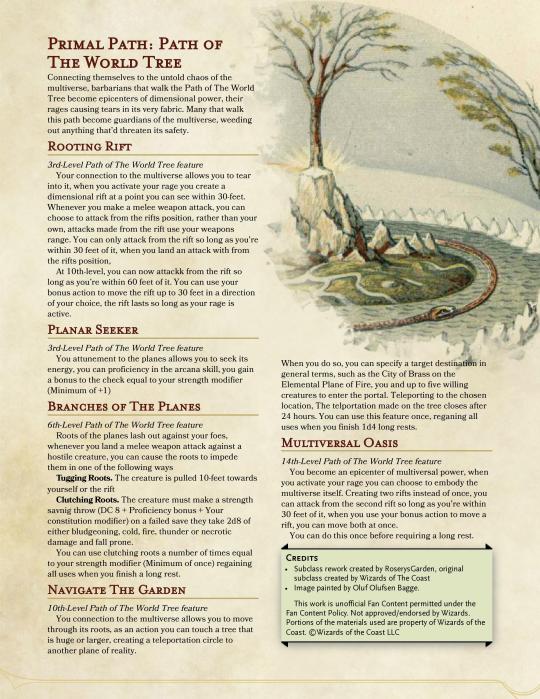
Hi there~! So If you haven't heard, Wotc has put out another unearthed arcana for One DND, 5.5, whatever its being called. In it came two new subclasses. The Brawler Fighter and The Path of The World Tree Barbarian, both of which I am not a fan of, but the world tree barbarian struck a nerve for me in particular cause it feels like WOTC has no idea what the subclass is supposed to be. So lets go over it
Vitality of the Roots is all the world tree barbarian gets at 3rd-level, it reads:
When you activate your Rage, you regain a number of Hit Points equal to your Barbarian level. At the start of each of your turns while your Rage is active, you can choose another creature within 10 feet of yourself to gain Temporary Hit Points. To determine the number of Temporary Hit Points, roll a number of d6s equal to your Rage Damage bonus, and add them together. If any of these Temporary Hit Points remain when your Rage ends, they vanish.
Okay cool, this is going to be a support barbarian, that isn't really a thing outside of maybe storm herald, cool feature right? Well let's get into the next feature, Branches of the Tree:
While your Rage is active, whenever a creature you can see ends its turn within 20 feet of you, you can use your Reaction to summon spectral branches of the World Tree around it. The target must succeed on a Strength saving throw (DC equal to 8 + your Proficiency Bonus + your Strength modifier) or be teleported to an unoccupied space you can see within 5 feet of yourself or in the nearest unoccupied space you can see. The space the target teleports to must be on a surface or liquid that can support it; otherwise, the target doesn’t teleport.
Now we're a controller style barbarian? The features alright but idk, it feels weird going from healing to control, lets check the next ability, Battering Roots:
Tendrils of the World Tree extend from your melee weapons. While you wield any melee weapon, your reach with that weapon increases by 10 feet, and when you hit with it, you can activate the Push or Topple property even if you’re using another Mastery property with that weapon
In case you forgot, the push property allows you to well, push enemies, and topple allows you to knock people prone, it's alright-if not particularly synergistic with the previous feature, but maybe they can bring it back with the capstone. Travel through the Tree:
As an action, you touch a Huge or larger tree or a Teleportation Circle to create a link through the World Tree to a Teleportation Circle somewhere else on the same world or on another plane of existence. When you do so, you can specify a target destination in general terms, such as the City of Brass on the Elemental Plane of Fire, and you and up to five willing creatures within 30 feet of you appear at the Teleportation Circle closest to that destination. If a Teleportation Circle is too small to hold all the creatures you transported, they appear in the unoccupied spaces closest to the circle.
Once you use this feature, you can’t use it again until you finish a Long Rest. If you’ve run out of uses of this feature, you can expend five uses of your Rage, choosing to activate this feature
instead of Rage.
Yeah, the capstone is basically a ribbon feature. I guess it'd be really good if you're playing in a multiversal campaign but otherwise, this feels really bad as a capstone. Like you go through the effort of getting your barbarian up to 14th-level (Btw, most campaigns at most go to 10-11th level, even WOTC's own adventures do this) just to use teleportation circle. Overall, while I love the idea of a controller barbarian (Especially since most barb subclasses focus on enhancing existing barbarian things, mainly tanking and striking) but the world tree barbarian just feels like a weird mess. So I decided to make my own version.
My version of the world tree barbarian is now focused around creating rifts in reality, which act as alternative positions the barbarian can attack from, say you have a band of goblins that are 30 feet away from you, but your rift is right next to them, you can choose to attack from the rifts position rather than your own, I choose to keep the pushing and pulling via Branches of the planes, the original capstone I converted into a 10th-level ribbon. And the capstone allows you to have two portals active at once, along with swapping places with existing rifts. Admitively i'm feeling a bit lukewarm on the subclass atm, but let me know if I did a good job, or if I made the worst subclass of all time.
That's about all I got for today, I might do more subclass reworks in the future so keep an eye out for that, for now I wish you farewell from the garden. Stay cool and make some homebrew.
#dnd homebrew#dnd5e#5e homebrew#dnd#5e#dnd 5e homebrew#dungeons and dragons#dungeons and dragons homebrew#homebrew 5e#dnd barbarian#barbarian
36 notes
·
View notes
Text
WIP Wednesday
Tagged by @melisusthewee, thank you so much! :3
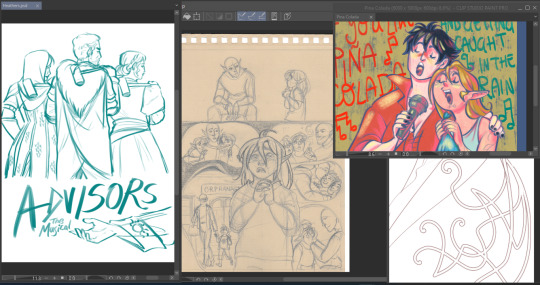
I like
Looking hot
Ending wars they cannot 🎶
(It's @ndostairlyrium's fault -also hi Ali you're tagged)
(it's a cit, if you know the musical let me kiss you on the forehead)
Going on with DadWolf. I like flashbacks, sue me.
Aisling getting kidnapped by all kinds of Hawkes, this time it's Raina. I tried to colour an old sketch. Still not convinced, but they're having fun.
Art nouveau thing that's kind of a secret for now.
Some writing from Monster Fic under the cut, I'm slowly progressing with all the fics.
Tagging: Ali as above, @shivunin @rowanisawriter @zenstrike @salsedinepicta (if you have something!) @scribbledquillz @layalu @daggerbean @rosella-writes
(of course ignore the tag if you mind it!)
Dear Aisling,
I’m sorry about the Herald. I think no one understood, here, how much it really upset you. I had no idea it was so bad, for once. I will stop it, forgive me if I didn’t really listen.
I’m not upset because you’re down there and just working through mails and reports. I am not, really, nor is Leliana, nor is Cullen (even if he’s grumpier than usual). The workload is higher without your physical presence, yes… But I get that the Temple is important. And we did ask a lot of you.
I’m not telling you you’re stupid, you’re not. But it would be a little difficult to replace you, particularly because Corypheus is looking for you… I don’t know what to say, Aisling. It’s… It’s late to step back, I think. Just that. I am sorry. I understand the need to throw everything in the gutter, but it is really not a good moment.
But you’re not Yvette and I know you don’t need me scolding you. Forgive me.
How are you, for real?
Beside the dress -it would be nice to know, but please don’t take it as it’s my main goal in writing you!
Life here it’s chaotic, but nice. I’m still not really used to the forest and its rhythm, and I do hate how many insects there are. I saw a moth the other day which was… The colour was pretty, but it was the hugest moth I’ve seen. I don’t wish to see another one ever again. But! It’s nice to fall asleep cradled by the sounds of the crickets and the parrots. It reminds me of when I was a child, in our family’s country house. My room had the lightest white curtains who would float in the wind, and I thought they looked like clouds. I miss those times. And swimming in the sea.
Have you ever swam in the sea? I don’t remember if I ever asked you. Maybe when this is all over we could all go by the sea and relax.
That’s a cute drawing! Is it a pheasant?
A hug back,
Josephine
(in the intention of the original artist, it was one of the parrots in the Arbor Wilds)
#wip wednesday#dragon age#dragon age advisors#cullen rutherford#leliana#josephine montilyet#dadwolf AU#aisling lavellan#sketch#doodle#writing petrel
30 notes
·
View notes
Note
Hiiiiiii, I really love your writing, especially the Uta stories and headcanons! 🖤 Can I please request from the promt word memory with Uta from Tokyo ghoul please? 😊🖤
Thank you for your request! Ah, I'm so glad that Uta is the first of this little experiment. Hope you like it!
Tokyo Ghoul, Uta x Human!Reader
Word: "Memory"

Uta has never had a close relationship with memory. He is someone who lives in the past maybe, but not in memories, on the contrary, if he can he thinks about them as little as possible: too painful, and if they are happy they are painful anyway because they have passed. He has never adapted to changes.
Or at least, so he always thought.
Yet now his eyes fall on a photograph, a photo of you two. It is, indeed, one of the very few photos exhibited in the house and to be honest he had completely forgotten about its existence, even though it’s in the bedroom.
A photo, which banal memory, you too admitted that it was not one of your brightest ideas, especially since he did not particularly like photographs. But he remembers how much you cared at the time, for many reasons.
First of all, fear.
Who knows why, he wondered, you were so terrified by the idea that he would forget you. Then he had looked inside himself, and understood.
You listed all the reasons why you could have disappeared: a trip, an accident, an illness, a robbery in the shop you used to go to (which shop?), attacked by a ghoul… you didn't mention his name.
"By me?" Uta asked you.
You looked at him in silence, and then you smiled: "maybe."
He hadn't added anything else on the subject, but continued: "There are Doves too, they could catch you ... or ..."The ghoul looked at the photo that was shining on your phone screen at that moment: his head was
folded over yours, his cheek against your temple as he tried to figure out what you were doing. He wasn't looking at the camera, but he was looking at you.
"Or I can get caught, who knows." He told you.
Your face was frowning: "You won't get caught."
It was bad of him, but he found it almost funny as it seemed that you had absolutely not considered the possibility of you surviving him: "I hope not, but who can say? I could be captured, killed, eaten by another ghoul… why not? I did it myself, you know? "
The confusion was so clear in your eyes: "You what?" You asked, but he didn't answer, he rather pointed to the photograph.
"Will you remember me?" His question in his mind almost sounded like a challenge, so your firm voice confused him.
"Of course."
You answered right away without hesitation, and he silently looked you in the eye, and then looked at the black screen. You turned it back on to make the two of you reappear.
Memory was a herald of pain for him: he imagined looking at your smile in that image and not being able to see it elsewhere, no longer having you next to him. That smile would have been a pain he would have gladly forgotten.
And you would have remembered him instead.
"Wouldn't that hurt you?" His was a genuine curiosity.
"More than you can believe." You answered him. He had seen a watery layer appear in your eyes and he knew you were imagining too. It was instinctive for him to lean a little more towards you.
"But… I can't give up on you. Not even in that case "
For a moment Uta couldn't get rations. Your words almost seemed to have a real weight that caused a physical reaction in his stomach, filling it with a hot tingle.
He knew what you were saying. Your love for him wouldn't go away with him.
You would have loved him in your memory, tenderly and painfully
Remember me like this, while I look at you.
It is a thought, he doesn’t know if of him for you or if he imagines it on your lips, but in any case that thought is not part of the memory, it exists now and is alive. His lungs expand and he needs to breathe.
As in response your head moves across his chest, sliding lower as you curl up against him.
"We should change it." He tells you, he knows you're awake even if you pretend not, your moan is a confirmation.
"What?" Yow ask after a moment's hesitation.
"That photo." It's not a photo that people would usually exhibit at home, in fact, but you are certainly not conventional.
He feels your weight on him disappear as you lift yourself up a little to see what he's referring to: "Oh." You murmur on a note of surprise. Apparently you didn't even remember.
"Then worry about calling a photographer if my skills are not to your liking," you joke, as you drop again on his chest.
A photographer. Of course. Now it is possible.
"We could do it, but it should be worth, for example for a wedding."
Silence in the night. Then your head rises again: you are looking at him, even if he is not looking at you.
He feels like laughing but he doesn't have to; he knows that now you won't sleep until the wee hours of the morning thinking about it, but in the end it's your fault that you filled his memory of him with beautiful precious dreams.
#tokyo ghoul#uta tokyo ghoul#tokyo ghoul x reader#uta x reader#uta x human reader#reader insert#tokyo ghoul uta#tokyo ghoul fanfiction#anime oneshot#request
248 notes
·
View notes
Text
'Cillian Murphy quite literally wandered into acting. At the age of 20, he walked up to the door of the Corcadorca Theatre Company in his hometown of Cork, Ireland, and knocked. He told the person who answered that he’d be interested in getting involved in any upcoming shows, and the man suggested he try out for a new play called “Disco Pigs,” about a pair of reckless teenagers. It was Murphy’s first audition, and he got the part.
The Enda Walsh play was a big success, moving to larger and larger theaters and eventually leading to a film adaptation in 2001 from director Kirsten Sheridan. That film caught the eye of filmmaker Danny Boyle, then looking to cast a fresh face for his post-apocalyptic thriller “28 Days Later.”
The rest is history — or history in the making as, 20 years later, Murphy is continuing to seek out bold projects with some of the best filmmakers working today. That includes Christopher Nolan, who first brought Murphy to supervillain stardom in “Batman Begins” and who directs the actor in the titular role in “Oppenheimer,” now in theaters. It’s their sixth collaboration, and Murphy’s biggest role yet, playing the complex physicist and “father of the atomic bomb” over a course of several years and a three-hour runtime. It’s one of Murphy’s finest performances, which is saying a lot.
There isn’t a genre or a medium the actor has shied away from over the years. And while some films might not always work as a whole, Murphy always shines. He’s also a true actor’s actor, one who understands every role is integral and is comfortable taking on supporting parts. Here’s a look at 10 of his best performances from his career on stage, film and television.
10. 28 Days Later (2002)

This is how most of the world was introduced to Murphy — a pair of impossibly blue eyes fill the screen as his character, a bicycle courier named Jim, awakes from a coma in Danny Boyle’s heralded action epic. He’s been asleep less than a month, but a lot can happen in that time — including the complete collapse of society thanks to a virus called “Rage” that turns its victims into mindless aggressors. (Note that the Z-word is never uttered throughout the film.) It’s a star-making turn for Murphy, only 24 at the time, who not only carries the film but holds his own against such impressive cast members as Brendan Gleeson and Naomie Harris as fellow survivors. Jim is discovering everything at the same time as the viewer, and Murphy makes the perfect audience surrogate, taking everything in with a suitably shocked but level-headed demeanor. He’s not a traditional action hero, and that’s the point: He’s just an ordinary man trying to navigate an entirely new world.
9. Batman Begins (2005)
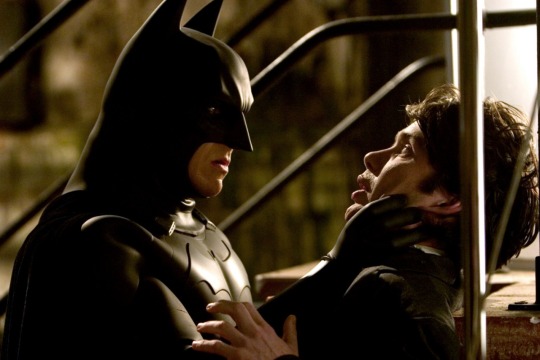
Prior to Christopher Nolan’s Dark Knight trilogy, films adapted from comics were a largely uplifting affair full of primary colors and bright locations. It’s easy to forget how much had to go right for “Batman Begins” to succeed, but it started with finding a villain who was as compelling as his nemesis. Though Murphy originally tested for Bruce Wayne/Batman, it was a stroke of genius that Nolan would peg him as Dr. Jonathan Crane, aka Scarecrow. With a charisma that can be both terrifying and seductive (which would become a Murphy speciality in years to come) Crane doesn’t need to showboat he’s the bad guy. Rather, he exudes a calm confidence, taking his time with methodical precision. Even the way he says the word “Batman,” drawing it out into two separate words, is chilling. It was wise of Nolan to include Scarecrow in the film’s two sequels — particularly in “The Dark Knight Rises,” where he pops up as a judge in a kangaroo courtroom with a smirk (“Exile or death?”) that shows he’s enjoying this almost as much as the audience is.
8. Red Eye (2005)
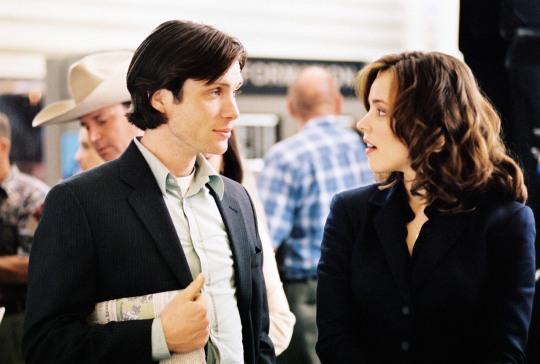
It would be easy to dismiss Wes Craven’s tight thriller — largely set onboard a red-eye flight in which a terrorist threatens a fellow passenger in order to pull off an assassination plot at the hotel she manages — because it’s so damn fun. But it’s also a clever, lean thriller buoyed by two actors toward the beginning of their film careers. Murphy is the perhaps too-aptly named Jackson Rippner while Rachel McAdams is his victim, Lisa Reisert. Part of the brilliance of Carl Ellsworth’s script is how the first few minutes play like a rom-com; two impossibly good-looking people meet cute at the airport and sparks immediately fly. Murphy understands that Rippner can’t telegraph evil — this is a man chosen for the assignment because he has deep resources of charm. They engage in a cat-and-mouse game throughout the flight that is so charged, don’t be surprised if there’s a part of you wondering if these two crazy kids can work it out.
7. Breakfast on Pluto (2005)
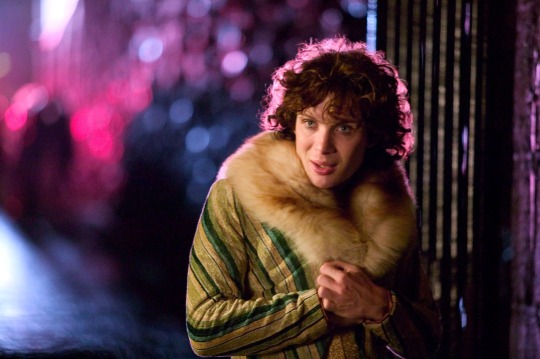
From the beginning of his film career, Murphy refused to be pigeonholed, seeking out unique projects and interesting roles without much of a concern for box office results. The same year he made his supervillain debut in “Batman Begins,” he pivoted by playing Kitten, the transgender heroine searching for love and her birth mother in Neil Jordan’s adaptation of Pat McCabe’s novel. While the casting of a cis man in the role might raise issues today, Murphy’s portrayal is a loving homage to the tenacity and tenderness of the character. Kitten is charming and determined, and Murphy finds a joy in her life even when things take a dark turn. It’s also a chance for Murphy to reunite with some of his previous co-stars, including Gleeson, Stephen Rea and Liam Neeson – forming a powerhouse of Irish performers.
6. Disco Pigs (2001)

Murphy’s feature film debut is an adaptation of the Enda Walsh play in which he made his theatrical (and acting) debut. Murphy stars as “Pig” and Elaine Cassidy is “Runt,” a pair of teenagers who have been devoted to one another since birth. Pig is all raging id, completely unpredictable and prone to violent outbursts. But Murphy also shows his deep vulnerability and affection for his friend, particularly as their relationship begins to shift away from purely platonic. It’s a stunning debut, and Murphy’s raw talent and potential are on full display. So much so that the film caught the eye of an up-and-coming director named Danny Boyle, who would go on to cast Murphy in his breakout “28 Days Later” role.
5. The Wind that Shakes the Barley (2006)

Ken Loach is such a perfect fit for Murphy, it’s a shame the two haven’t collaborated on another film since this tale of two war-torn brothers during the Irish War of Independence. Murphy is Damien, a doctor who initially wants no part of the fighting, resigned to the idea that the war is unwinnable. But after witnessing several injustices, he impulsively joins the Irish Republican Army. Murphy portrays the transformation into a radicalized soldier who ultimately sacrifices everything for his cause without ever hitting a false note. It’s a heartbreaking, emotional journey that grounds the film, which went on to win the Palme d’Or at the 2006 Cannes Film Festival and is regarded by many as Loach’s best.
4. Peaky Blinders (2013-2022)

Murphy has always been drawn to the written word, no matter the medium. So after headlining films from the likes of Danny Boyle and Neil Jordan, he made a point to return to the stage and had no qualms about signing up for a television series penned by acclaimed writer Steven Knight (“Dirty Pretty Things,” “Eastern Promises”). The actor is a perfect fit in Knight’s universe of morally compromised men you can’t take your eyes off of. His Tommy Shelby is a war veteran turned leader of the Peaky Blinders criminal organization. His work is all pragmatism: He’s often stoic as he manipulates and calculates. But he’s also haunted — both by what he’s seen in the war and by his deep and abiding love for his late wife Grace. Of course, Murphy is so magnetic, fans of the show often have to be reminded that he is actually a villain. Put aside the mass murder and corruption — I’m still not over him shooting that horse.
3. Oppenheimer (2023)

After five collaborations with Nolan, the filmmaker finally let Murphy take the lead — and it was worth waiting for. Murphy portrays the rise and fall of J. Robert Oppenheimer, the theoretical physicist known as the creator of the atomic bomb. Murphy ricochets through time, portraying Oppenheimer in his young adulthood as a fragile student, his glory heading The Manhattan Project and his later years where he’s fighting the government that once heralded him. These three timelines are usually easy to distinguish from one another, but sometimes they flow together with no obvious way to differentiate –yet Murphy is always precisely where he needs to be. Though Oppenheimer is a mass of contradictions — he can be controlled yet irrational, naïve yet arrogant — he always makes sense through Murphy’s interpretation. He is particularly haunting playing Oppenheimer in his later years: Both physically and spiritually, you feel like you’re watching a man fading away before your eyes.
2. Misterman (2011)
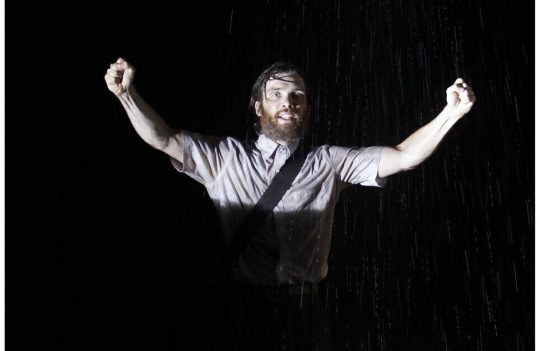
For this tour-de-force, Murphy went back to where it all began – not only the theater but specifically a play by Enda Walsh, whose “Disco Pigs” set Murphy on his journey as an actor. He plays Thomas Magill (never “Tom”) a loner and fanatic on a mission to cleanse his small Irish town of its sins. Murphy is the only actor on stage for the duration of the play, but this is not a staid affair — he literally bounces off the walls, hurls objects and races back and forth — all as he builds his story to a powerful crescendo. It’s exhausting just to watch, and yet you won’t be able to look away. While Murphy performed the role on several stages, it was also filmed as part of National Theatre at Home series for Landmark Productions, who show it on occasion. Keep an eye out, as it’s not one to be missed.
1. Inception (2010)
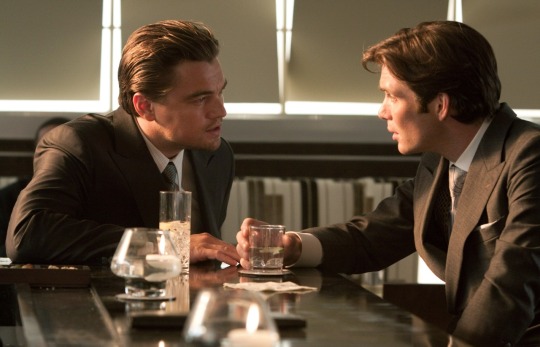
When citing Murphy’s collaborations with Nolan, it would make sense to favor “Dunkirk,” in which he offers a harrowing depiction of PTSD as a traumatized solider; or “Oppenheimer,” in which he occupies nearly every frame as the star of the film. But for me, Murphy is the lynchpin in one of Nolan’s best, most ambitious and most emotional masterpieces, the byzantine thriller “Inception.” He plays Robert Michael Fischer, the heir to a business empire whose unresolved daddy issues make him the target of a team of “extractors.” Led by Leonardo DiCaprio’s Dom Cobb, the thieves use dream technology to infiltrate the subconscious of a target to access information. Fischer is a man of few words and Murphy is fantastic at quietly communicating his pain and making you care for a character that is, in many ways, intended to be a cipher. Murphy shows that “best” doesn’t need to mean “most” — both in terms of the size of the role and the acting, delivering a sublime supporting performance that the entire movie rests on. Nolan is often accused (wrongly) of being a cold filmmaker. But the moment where Fischer finds closure with his late father is perhaps the most affecting gut-punch he’s ever delivered, thanks largely to Murphy’s beautiful performance.'
#Cillian Murphy#Christopher Nolan#Ken Loach#Enda Walsh#Disco Pigs#Danny Boyle#Corcadorca Theatre Company#Oppenheimer#The Wind That Shakes The Barley#Misterman#Inception#Breakfast on Pluto#28 Days Later#Leonardo DiCaprio#Peaky Blinders#Tommy Shelby#Steven Knight#Dirty Pretty Things#Eastern Promises#National Theatre at Home#Palme d'Or#Cannes#Red Eye#Rachel McAdams#Wes Craven#Batman Begins#Dr. Jonathan Crane#Scarecrow#Brendan Gleeson#Liam Neeson
24 notes
·
View notes
Note
How would you rank ever Ghidorah Design, from worst to best? Or in a tier format, if you'd prefer.
Alright, let's go in order of worst to best.

Keiser Ghidorah is the worst Ghidorah. I am of the firm opinion that Ghidorah needs to be Beautiful and Awe-Inspiring first and foremost, because it's part of how he works as a foil to not only Godzilla, but really ALL of the heroic monsters in Toho's pantheon, and what makes him such an iconic villain as a result. Ghidorah is magnificent, splendorous, and everything humans find laudable on the surface level. He's the color of gold, he has large and lustrous wings, he's got a crown of horns and a voice like a bell, and all these things make him prettier and more pleasing to the average human than monsters like Godzilla and Rodan - which makes how fucking nasty he is all the more striking.
Keiser Ghidorah fucks that all up. He's got these stunted wings, this pathetic thin little rat tails, and this lumpy, misshapen body with nasty little heads. He looks uglier and more stunted than Godzilla, which makes the fact that he's nastier, well, pretty expected. He's big, but he has no majesty. He's not a heraldic beast, his a stunted miserable wretch, which makes him getting his ass handed to him by a different stunted miserable wretch a lot less interesting. Just a shit Ghidorah.
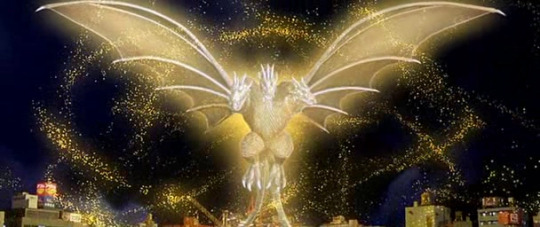
The plus side is that pretty much every other Ghidorah design is a fuckin' banger. GMK Ghidorah is technically my second least favorite and it's still a damn good design. GMK is such an oddball in terms of the mythos of these characters, with its explicitly evil Godzilla and benevolent Ghidorah, but even with the very different takes on characterization they manage to make the pair's relationship as foils meaningful, just in a different context - a heroic and heraldic Japanese dragon from the country's history is literally dwarfed by a far more modern manifestation of monstrosity, and, though he is outgunned, the mythological figure stands tall and shines bright as it defends Japan against an unstoppable force.
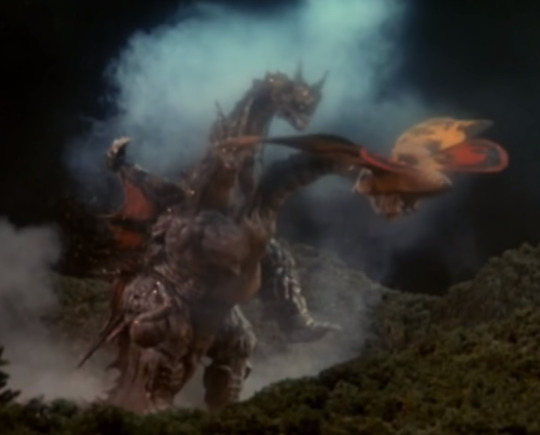
I don't know whether I should include Death Ghidorah here since he's really his own character, but fuck it, I'm going to do it anyway. Even with his more explicitly evil color scheme, he does what all the King Ghidorahs should, looking regal, magnificent, and awe-inspiring while being an evil bastard beneath the draconic splendor. Just because he's a goth where most Ghidorahs are preps doesn't mean he can't be just as fabulous.
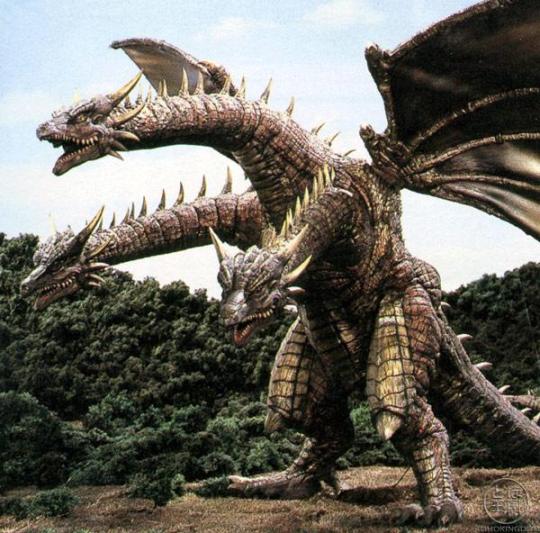
Cretaceous Ghidorah is in a similar boat - he's technically aiming for something different than the standard Ghidorah vibe, but he still manages to accomplish what a Ghidorah should. Yes, he's not quite as regal as a King Ghidorah would be, but you can still see the splendor there - it's just subdued, because this is young Ghidorah, a Ghidorah who hasn't quite come into his Kingdom of Terror. A Prince Ghidorah, if you will, and he pulls off that princely look quite well.
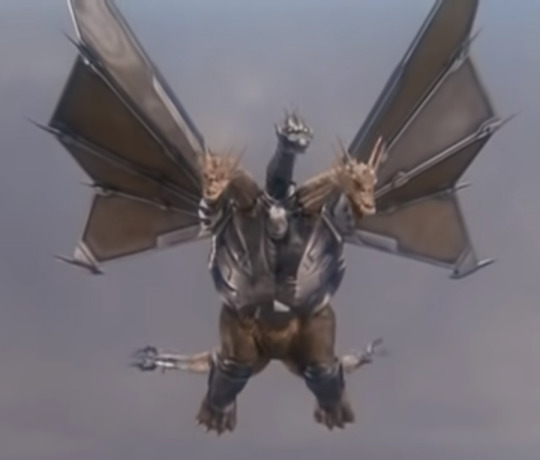
Mecha-King Ghidorah is basically what he needs to be to live up to his character concept. I like/prefer the fact that he's visibly a cyborg rather than a pure robot - that Ghidorah's malevolent power could not be fully replicated with machinery, but instead simply restrained by it, albeit in an extreme fashion. The character himself isn't used particularly well in his movie, but design-wise it's a solid concept.
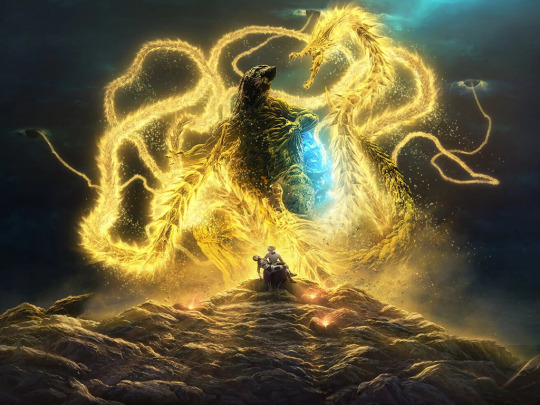
Planet Eater's Ghidorah was one of the few things in the shitty anime movie trilogy that was good in both concept AND execution. My personal stance is that turning Ghidorah into an eldritch abomination is an unnecessary change but not a bad one - a lateral move, really, depending on how it's executed. But for the anime movie trilogy, a creative choice that's a lateral move is WAY higher than average. I like the serpentine necks, the shining and almost angelic glow on Ghidorah's golden form, and how our space monster appears from black holes to really hammer its unnatural nature in. The only thing I don't like about it is the ugly face they gave it - I reassert my stance that Ghidorah should be pretty, and that gnarled twisted mouth and cluster of pustule eyes mars the pretty factor. But the golden glow makes it pretty unnoticeable, and the fact that Ghidorah's arrival finally made this series watchable makes me forgive that slight flaw.
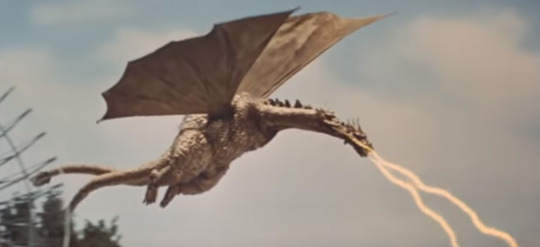
The original Ghidorah is beautiful and nearly perfect, being the one who established the criteria by which I judge all other Ghidorahs. Love his furry manes, crescent moon-shaped head spikes, and his very non-European dragon faces.
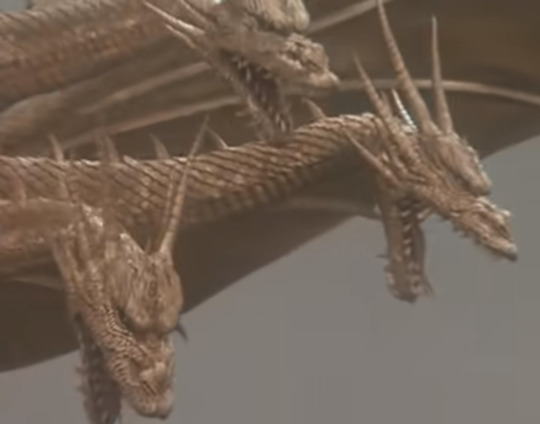
...but I like the crown of horns that the Heisei Ghidorah sports just slightly more. Ghidorah's a king, and the crown look is just so perfect.
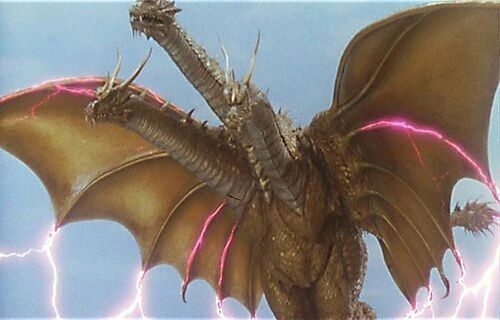
Rebirth of Mothra III's Grand King Ghidorah takes the Heisei design and blends in those crescent moon horns from the Showa design. If his lesser horns were a bit longer and he had Showa's manes he'd be pretty much perfect! Look at his grandeur!
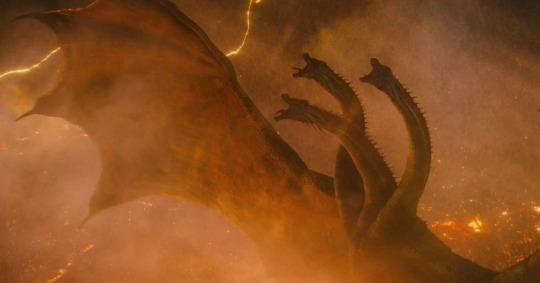
As it stands, my favorite Ghidorah is the 2019 take. The regal splendor is on full display, he's got his crowns, and he goes hard on the mythology angle of the original Ghidorah that so many people seem keen to ignore. I miss the fan wings a bit, but the fact that this Ghidorah's wing structure is based on those of William Blake's depiction of Satan goes a long way in my devil-loving heart. If he just had some lustrous manes, he'd be pretty much perfect.
59 notes
·
View notes
Text
I've seen the collaboration with Milgram drinks and considering that they are specially personalised for each character I decided to find some symbolism in the drink's contents.
Because my last posts had been with Muu, I decided to begin with her. ~🐝
(mentions of suicide, murder! )
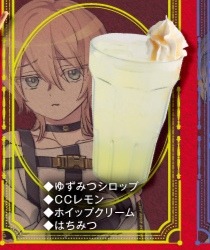
Translation: (It was done with some apps so I'm not very sure how good is this translation, but let's hope for the best!)
~Yuzumitsu syrup~🥤(I think it should've been yuzu and honey?)
~Lemon~🍋
~Whipped cream~🍨(the second one looks a little bit like in the photo)
~Honey~🍯
Now let's start!
~Yuzu fruit~

"Yuzu is a citrus fruit that is native to East Asia, specifically China and Japan. It is a cross between a mandarin orange and a pomelo, and is known for its unique flavor and aroma. The fruit is typically small and round, with a thin, bumpy skin that is bright yellow when ripe."
-> "Yuzu has been an important part of East Asian culture for many centuries. In Japan, the fruit has been associated with the aristocracy and the imperial court, and was often presented as a gift to the emperor."
To sum it up, Yuzu is a symbol of wealth and luxury.
This easily links to Muu as she admits that she comes from a rich family and she is often provided with everything she needs in the interrogation questions, but also in voice dramas. Even her second MV in where she is portraited as the queen bee is a good example of her higher status. Funnily enough, to fit the bee theme she is given honey in shape of larvae, which has another similarity with the description below where the emperors received Yuzu as a gift.
->"In Chinese art, yuzu has been depicted in traditional Chinese paintings, particularly those related to nature. Yuzu is depicted as a symbol of longevity and auspiciousness(promising success) ."
Again, because of Muu's higher status, she was meant to have a very successful life, if her murder never happened. She admits having received many model scouting offers due to her natural beauty and her mother's career. Also, a lot of money means that she can pay for her medical needs so, if not for some accidents or some sort, she would probably have lived a long life.
->"People heralded yuzu as a powerful fruit for more than its medicinal properties and its ability to leave your skin silky smooth after a soak. It was also regarded as auspicious due to its bright, sunny color and strong, fresh fragrance. Many believed soaking in a yuzu bath on the Winter Solstice invited health and fortune for the new year. Some even believed the powerful aroma could ward off bad luck and exorcise evil spirits!"
Okay, here a many things that I want to cover up, so I'll make it short.
Medical properties and smooth silky skin can again link to Muu being very healthy and very beautiful. But what I want to point out is the yuzu bath, which is said to ward off bad luck and exorcise evil spirits. Muu often says in her first VD that Rei was a bad person and was the actual cause of her misfortune. This fruit could be a metaphor of her crime, because Muu by murdering Rei (in her pov)she got rid of the source of her bad luck and suffering.
Even the Winter Solstice itself points this out. By the standard definition winter Solstice is marked as "the symbol of death and rebirth of the Sun". Muu is often portraited in yellow colours, so by thinking of her as the sun we can interpret this way: Muu's old bullied self died as soon as she killed Rei and was rebirthed as a more confident person freed of pain.
If Muu were a fruit, I would say that Yuzu will definitely be a perfect choice, so no wonder Milgram chose this fruit for her drink.
~Lemon~

->"The lemon has come to symbolize many — sometimes opposing — ideas, depending on the cultural reference point. Sometimes it is considered a symbol of longevity, purification, love, and friendship, and other times it is seen to be symbolic of bitterness and disappointment. Catholic tradition linked the fruit to fidelity. Because it was imported at great expense to some countries it became a symbol of wealth."
I will not explain again the longevity, purification and wealth part as it will be just me repeating myself. Instead, I will talk about friendship which is an important theme to Muu's character.
I will begin with Muu's views about it, because I think it will be a better introduction.
"Friends aren't like that you know. Rather than using each other for something, we just get along because we're comfortable around each other. That's all."
Muu thinks that friendship means to be yourself without the fear of being judged. To talk happy about silly topics, to express yourself in a comfortable atmosphere, to get along with people that understand you. At the surface, Muu's idea of friendship it's the standard definition. However, if we dig just a little bit, we easily see that Muu doesn't truly respect her ideals or rather she is using this definition to the extreme. When confronted by Es about Haruka's intention to keep her safe, Muu admits that she already knows about it. She is happy, because Haruka wants to protect her from a possible guilty verdict. After that, she explains that she will not stop him from killing himself if that's what he wishes, because according to her "Isn't friendship about letting your friends do the things they want?". Again, just by definition, it is a correct affirmation. Friendship means to help your peers achieving what they want and supporting them on their journey. But Muu takes this definition to the extreme. Friendship doesn't always imply that you should let the person you care about to do whatever they want. This is just negligence. Sometimes they need a reality check or words to convince them that what they want to do at the moment it's not the best choice and should find another solution or simply to abandon that idea.
Muu then ends her friendship talk with an interesting sentence. "Then what is friendship? You're together because it's beneficial for everyone involved, aren't you?"
By theory, what she says is true. Friendship is needed in humans life, because we can't properly live without other persons to interact with. Even if we talk about a connection that it was made simply because you share a class with and you don't want to be lonely or a relationship that actually lasts for a lifetime, they are important for our development.
In Muu's case both her and Haruka are benefiting from their friendship, not only as a way to pass time and keep sane in a magical prison, but also for their own desires. For example, Muu thinks that the most important thing that a friend should do is to listen to what she has to say, something that Haruka is actively seen doing.
(from the interrogation questions)
What's a friend in your opinion?
"People who listen carefully to what Muu has to say."
So Muu seeks people that listen to her and with whom she's comfortable in a friendship. In the second MV the scene where the "bees" are around her could be a metaphor for her wanting to be listened(after all, what a queen says never gets unnoticed), but also in this specific scene she looks the most comfortable around her friend group.
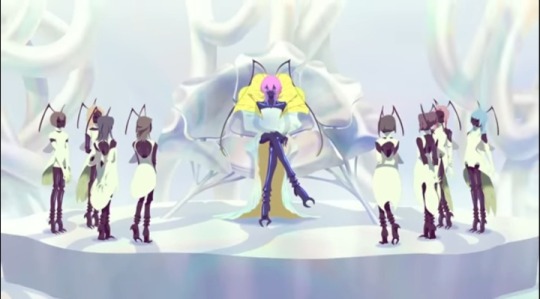
Okay, but what her friends are benefiting from this relationship? Considering how easily they betrayed her trust means that it was never a very deep connection to begin with. That's because what they gained were objects, expensive things. Muu's love language and appreciation is giving things to others. Being rich means that she can afford many items so for her it's not a big struggle. In after pain the text from her phone suggests that she gave her lipstick to one of her friends.
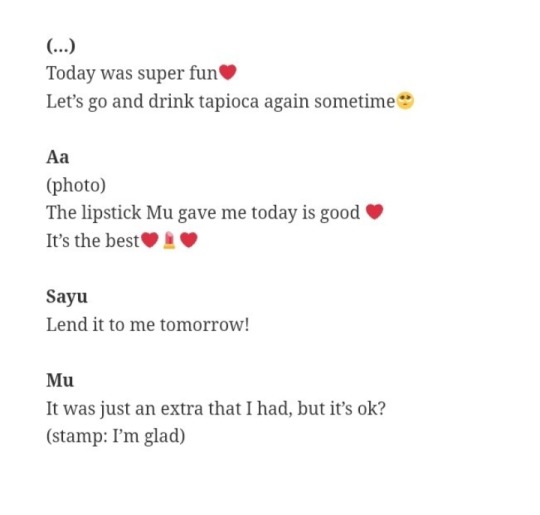
Also, to who she gave something to as a sign of friendship? To Haruka! The hairpin.
Her friendship at school was most likely superficial, based more on materialism, and was never a deep connection like Muu wanted. Despite that her views of friendship seem like the standard definition, because they were taken to the extreme, she didn't realized until too late that her friends were superficial and didn't care much about her.
And even after all this she still wants to see her friends again, meaning that Muu still cares somewhat about them.
"At the moment is there anyone you want to meet?"
"I want to meet my friends, but in the first place there's daddy and mom I think~"
At the same time though, she is disappointed with how everything turned out to play and how easy her friends started to bully her.
"Do you regret it?"
"Mhm, I should've chosen my friends better."
What did lemons symbolise again? Disappointment, bitterness and fidelity. What Muu feels now about her past friendship and the loyalty that she never had truly gotten, but wants to.
Lemon is a fruit that represents very well Muu's desires and it's sad that such a simple wish (friendship) was too hard to be granted.
~Whipped cream~🍨
I will not talk much about this, since there is not much to say.
Whipped cream is used a lot in desserts, sugary things. Usually, it symbolises a carefree attitude and a joyous mood. This could make a reference to Muu's actual state of mind in Milgram, her being one of the only prisoner who is still fine, both mentally and physically.
~Honey~🍯

"Honey symbolises positive things, such as abundance, wisdom, and even the word of God."
I think it is no wonder that honey is an important part in Muu's character considering the second MV.
Her second MV adds information about Muu's murder and uncovers us the revelation that she was once part of the bullying group. So based on the symbolism, we can say that honey represents truth.
But what does honey represents in her MV? Muu associates it with devotion in the lyrics, which makes sense considering the visuals. The first bee scene that we have is Muu being surrounded by other classmates. Almost all of them have a plate with honey waiting for her to delight with the food. Just one of the bees has an empty plate that doesn't get unnoticed by Muu, who with just a slight push, breaks her into pieces.
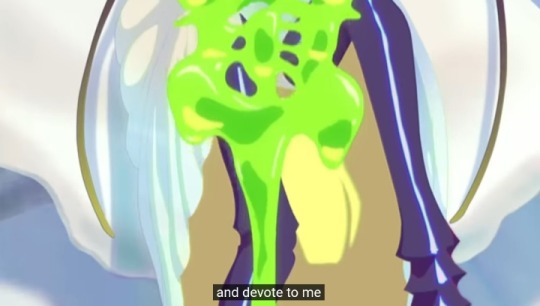
And not just the visuals and the lyrics are showing that honey means devotion and loyalty.
"She will stop from time to time in the hive, to be groomed and fed by the worker bees called her 'attendants.' They form a circle around her, and will also spread her pheromone through the hive. This queen pheromone tells the bees that she is alive and well."

The scenes from the MV are mimicking the bees in real life. Her friends, the worker bees, by giving her honey, are showing how much they value their friendship. So it's only naturally that the girl who doesn't give her honey (in Muu's point of view) it's like she's wishing for her downfall.
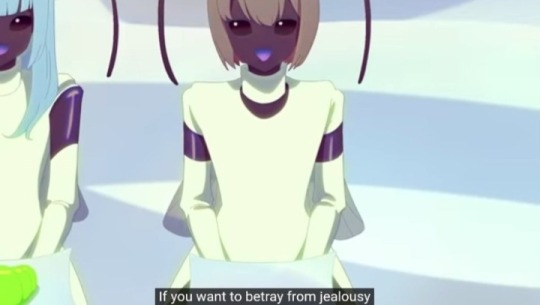
Another thing... (feel free to ignore, because it's just me being annoyed at the bullies) Honey symbolises sweetness in life. I can't shake the feeling that by giving Muu this sweet honey, they are flattering her so they can receive more expensive things. Even the text on the phone seems like the friends are complimenting her too much?
Anyway, back to the analysis!
Also I want to point out the shape of the honey, which are bee larvae. Normally, the queen bee is the one that makes them to assure that the colony is prosperous. Instead, Muu eats them, indicating how her friends circle is slowly diminishing and, in the world of bees, the colony is slowly wiped out.
It doesn't help that Muu's actively destroying the colony by breaking the worker bees into pieces. If Muu and her friend group believe that the respective classmate is treating them badly or "betraying from jealousy", they are cutting ties with that person removing them from the friend circle and target them as the new victim of bullying. A good example is the short haired girl from the thumbnail, which resembles a lot the first bee with the empty plate.

Basically, Muu believes that if a classmate is treating her badly she is being bullied by them, so her deciding to bully them back is a sign of revenge. Her voice drama also implies this assumption.
"You see, if you think that me bullying someone back after being bullied is the natural course of events, then wouldn't it be bad to bully me back again in return?"
To sum it up:
classmate (doesn't value the friendship/does something that Muu and the friend group dislikes) is a bully in their Pov -> they bully back as an act of revenge
Rei is interfering(wants to stop the bullying)-> Muu is the new victim of bullying and is betrayed by her closest friends
Muu thinks the only way to escape is by killing herself -> ends up killing Rei (revenge)
Muu implies that by giving her a guilty verdict we basically are telling her that it was wrong for her to seek revenge. However, it also means that Rei was wrong to instigate the bullying, again, as an act of revenge.
"But if you were like, "I won't forgive you, Muu! Revenge is bad!," then wouldn't that imply that it's also bad for me to bully someone back after they bullied me? Since we've all done something bad anyway, doesn't that mean that I've not done anything wrong in the end?"
And she ends her argument with the fact that she and her victim are even, meaning that she didn't do anything wrong.
Now that we have the bullying part cleared up, let's end this with the last scene from the MV were honey appears.
Throughout the MV, we see that the queen cell above Muu is glowing when she is eating honey. That is the place were all the honey is deposited and is spilled out when the fully developed Muu with wings escapes.
In the first MV the hourglass was used to represent how much Muu could endure the pain until she would've suffocated(literally). That queen cell could symbolise the same thing. When Muu escapes, the honey that was once a sign of friendship and loyalty was now suffocating her due to the fakeness and the betrayal of her friends. She is no longer looking at the spilled honey, and is happy that she can finally break free since there is nothing left in the broken hourglass(not even her three closest friends).
Honey is a good representation of trust and devotion. It showed the truth of the situation, how too much sweetness in one's life could cause someone to "suffocate" in the lies hidden in it (in this case, the false friendship that Muu believed she had).
Thank you for reading! ~🐝
Credits
#tbh it was done as an excuse to tell how I interpretated her MV#this was so hard to write#it took me 4 days to write and I dislike it because of how many times I read it#I was thinking to do other drinks for the other characters#But i feel like this will not reach anyone because I haven't posted for a while#idk who I will do next so if anyone has a preference i don't mind to do it#however I only wrote for Mahiru Yuno and Muu until now so I hope that I will manage#maybe I'll do a poll? I don't mind if people send me a message with the name of the character that they want though but I'll see!#I hope that'll I have time to post something until the end of this summer#milgram#milgram muu#muu kusunoki#character analysis#theory#drinks#fruits#honey#queen bee
20 notes
·
View notes
Note
People always say that "fucked up looking deer = top tier eldritch body horror." Do you think there's another animal that people should be fucking up in their horror stories just as frequently?
To quibble a little bit with your language, I think that fucked up deer is amazing horror, but not body horror. The fucked up deer is horrifying because it's an object most of us are generally familiar with, made other, made strange. The fucked up deer functions the same as the Victorian doll with the crack running along its fine porcelain face, animal carcasses hanging or nailed to trees in the woods, or alien rituals where people jump from cliffs, stop sleeping to sacrifice themselves to the god of coffee, or place toads in their mouths---to the horror of the audience and our designated stand-in. Indicating that something is wrong by means of a fucked up [blank] is an important mechanism of horror, and while I love deer specifically (I'm a US Midwesterner, sue me) it's not particularly special, just something that gets me where I live.
The best body horror is when you do perform that strange othering on the human body itself. It's the girl from The Ring crawling in jerky movements, the girl from The Exorcist swearing, speaking in tongues, or even (I hate to cite this as an example, but) the dislocated jaws and burst-open spider egg sacs from the most recent seasons of Stranger Things. It's Eric LaRocca's novellas talking about the beauty of staged dead bodies and parasites growing in your belly; it's Agustina Bazterrica's "Tender is the Flesh," which lingers lovingly on the dispassionate, clinical cannibalism inherent in its setting. If I can reference my own writing, it's skin rippling over what's hidden beneath and coat rack-thin wings not supposed to be growing from your scapulae and all the things about your body that don't make sense, don't obey conscious rules, seem to come from something other than you, whether that's a foreign, internal country, or external to your shape altogether.
(There's a reason there's a lot of great trans horror out there right now.)
Really what it comes down to is irony---the way that it's defined by English teachers, that conflict between what's happening in the narrative and the awareness you bring to bear as a reader. I don't think there's any single way to signal this horror! The fucked up deer, the mysterious pain in your gut, the ghosts, the beetles, the school friend who invites you to his ancestral home but retreats to his room before supper every night, the ring of keys you definitely set on the side table but find in a locked attic room three hours later, the chapel in the woods painted with bloody sigils, the ominous flicker on the security footage...
The means of communicating that the world has been broken are endless. I really don't think any one is better than the others.
But the best one is whatever communicates it clearest, sharpest; whatever stands out most against the backdrop you've established as wrong, as wrong, as bad and a herald of worse to come. Whatever makes your reader or watcher clench their jaw and hiss crap between their teeth---that's the best one.
143 notes
·
View notes
Text
When I was in college, I worked the graveyard shift at a local convenience store. It wasn't the best job- long hours, low pay, and boring as hell- but with the economy in those days I was happy to have any job to put food on the table. And besides, sometimes I'd get to meet interesting people.
One particularly memorable encounter was in November of that year, when a man walked in at 3AM wearing a full suit. This was already unusual in and of itself, I rarely saw anything fancier than a hoodie, but what he said next really caught my attention.
"Excuse me, but I seem to be a bit out of sorts. Could you tell me where I am?"
I gave the man a once-over. His eyes were clear, and he seemed too calm and put together to be on drugs.
"It's... the Amesville Savemart."
"Amesville? Why would they take me to..." He trailed off, staring over at the magazine rack on my counter. "And is that... today's paper?"
"Yup. Well, yesterday's, technically." He continued to stare at it, mumbling something under his breath. Slightly unnerved, I rested my finger on the alarm button below the desk. "Look, do you need me to call a cab, or..."
"No, no, that won't be neccessary." He picked up the newspaper, then took a lap around the store, grabbing all sorts of things- water, gum, shaving cream, candles, jerky, a lighter.
He brought each item up to the the counter, and I scanned and bagged them as he went. "Alright, will that be cash or-"
"This should cover it." He set something on the counter, then grabbed the bad and headed for the door.
"Hold on sir, you can't-" but he was already out the door, the familiar chime heralding his exit. I glanced at the trail of dirt he'd left behind him, then down at the item he'd left as payment. A small coin, golden by the looks of it, with a strange symbol carved into its surface. In the harsh flourescent lights, it almost seemed to be glowing.
I slipped the coin into my pocket. Maybe I'd just tell my boss there'd been a shoplifter.
9 notes
·
View notes
Text
here's a chunk of text i wrote for hell game 2 that i'm debating the canonicity of. i will probably tweak some of the implications. this is, surprisingly, not pornographic.
There's an Abomination here: a collection of organic parts, mostly bone and muscle and chitin, formed into something approximating the locomotion framework of a particularly large hyena-wolf. Fruiting bodies sprout from across its back in white-blue tendrils. Its head is the most directly analogous: a cage of rotted bone, worn away into irregular, asymmetrical pits, each of which opens into a glowing yellow eye, half ruptured and oozing ichor down its face. Below that, there's an articulated mandible -- a jaw -- that yawns open, a mess of fat tentacles spilling out like frothy tongues. That's an accommodation to human foibles; they don't need a centralized sensory locus the way humans do. But humans like having something to look at when they talk to someone.
This isn't a Hell thing; these were on the station before the disaster. {SWITCH %PC.startSpecies: human -> It's a little comforting to see someone familiar. You think you had a work-shift with this one, maybe. / ai -> ... }
ABOMINATION: Ah. {= %PC.name}. What's your sitrep?
-> Bad.
----
Abominations were originally conceived as an information extraction/torture device during the Third Martian Conflict. When Phobos was deorbited at the height of the war, hotlabs on the moon had their habitats ruptured during the impact, and the first generation of Abomination spores circulated free within the Martian atmosphere, eventually obtaining complete biosphere dominance. Abomination bioframes still present many theming elements drawn from Martian flora and fauna that were absorbed during their initial rampancy.
The initial assumption was that Abominations were mere grey goo: some kind of insensate matter reprocessing virus, specifically targeted to extract and store information from neural tissue they consumed. That may or may not have been their original design; historical records are thin on account of their origin hotlab having crashed into another planet and then subjected to several decades of Abomination-dominant biosphere.
In the aftermath of the war and the total loss of Mars, the interplanetary community was at odds for what to do with the Abomination incursion. A human -- or anything we would consider 'a living thing' -- existing in shared atmosphere with an Abomination fruiting body would be incapacitated within minutes, and kept alive but in excruciating pain as they were slowly flensed apart and had all their biomatter repurposed for the use of the local hive network for the next several weeks. It was a form of life inherently designed for use as a biological weapon. Even if they were, unexpectedly, sentient and capable of communication, it was a form of life that seemed impossible to live alongside. Abomination communicated among themselves with spore signals and mycorrhizal webs. Imagine if your eyes killed anyone you saw, and your voice had the force of a bomb.
Any official {UN; united federation of planets; w/e} response was preempted by the release of the first-phase Abomination antigen in the Martian atmosphere. The antigen bound to the spore network and disrupted fungal signals, effectively sterilizing their inter-body communication and utterly destroying the emerging hive network. At the time, though controversial, this was heralded as a huge step towards interspecies coordination. It made them 'safe', incapable of accidentally devouring everything their thoughts turned to. Once it became clear it was impractical from scientific, biological, and political to remove the antigen, several different strains were prototyped, allowing Abominations some level of hive connection without rising to a dangerous (to humans) threshold.
That was the state of things for nearly two hundred years, until contact was made with an unaltered hive trapped in Martian orbit since the Phobos deorbiting. Careful study and synthesis between the Abominations in orbit and a crew of rebel scientists, most Abominations themselves, lead to the development of a Human tolerogen gene therapy. The human staff of the research group voluntarily inoculated them, allowing them to inhabit the same space as Abominations without either species being in danger of being eaten alive or having all their senses burned out of them.
This was, in a very real sense, an existential threat to humanity. Altering the Abominations by cutting off their eyes and hands was one thing, if it was needed to keep humanity pure. Altering humans to make them compatible with the Abomination hive-networks meant that on a deep, biological level, humans who went through the process were no longer humans. They expressed different biological markers in all forms, from egg to death. To call the widespread use of the tolerogen gene therapy politically contentious would be understating things enormously.
The initial gene therapy altered and amended human biological processes sufficiently to make them capable of rudimentary integration to the Abomination hive-network. Incidence of development of psychic powers from access to Abomination communication flows rate at 0.013% of human population converted, and are a source of quiet humor to Abominations, where even the most 'psychically-active' human is very much like a toddler constantly polluting their network with uncontrolled, unexamined babble.
Large amounts of study have been put towards plant & animal bioengeering; altered humans are mostly-inert receptors, but Abominations still have a tendency to strip biospheres bare to reinterpret and process all foreign materials. As collective humanity makes its first steps out of the solar system, a source of hot debate is that our combined biosphere is intensely aggressive to any life lacking very specific biomarkers. Ecological contamination from space exploration has always been a concern, but once a majority of humanity began harboring a specifically-engineered consuming biovirus the topic became more contentious.
In much the same way human habitation is defined by a certain pressure level and gas mix, it's becoming increasingly clear that in the future the expansion of the human bionetwork will involve highly specific signalling chemicals, as much a part of the spread of collective humanity as gut flora and skin mites. What is a biosphere, if not a collection of process that attempt to choke out competing ones on contact? Collective humanity's is just considerably better at it than most.
Unaltered flora and fauna have been limited to preserves that inevitably decline in size yearly, given the impossibility of sharing atmospheres without fear of cross-contamination. The latest issue, as of {year marker; current day basically}, is the fundamental extirpation of all life not tailored in some sense for coexistence with collective humanity. It represents, perhaps, a new stage in existence, one where all biological processes that exist throughout the solar system only exist by the consent of bioengineers who have specifically designed them to work. The ending of nature, or, perhaps, the unleashing of a new kind of nature. Evolution still happens within the spore network, after all.
That a lot of them decided to look like giant nightmarish wolf-things is a joke. Humanity domesticated the wolf, after all.
anyway, you can fuck it.
5 notes
·
View notes
Note
How can you support this show
Creating content does not imply unequivocal support. But I'll bite. Despite its many sins, particularly with regard to representation (which is not unique among Lucasfilm stories - please read that linked post if you haven't before), I would ask, after viewing the show:
💀 Could you have more compassion for a veteran struggling to transition, recalling the whiplash of a tremendously capable Sergeant suddenly barely being able to feed his family while they live out of their car?
✋🏾 Could you more readily accept that trauma recovery is a fractious, nonlinear path, and "grumpiness" might actually herald the affected regaining sense of self by re-asserting their commitment to justice?
⚡ Could you have more patience with people whose brains work a little differently, appreciating that a blunt and unemotional communication style might not belie callousness, but represent their genuine effort to connect?
💣 Could you create more space to recognize that a scarred and physically intimidating person might also have the greatest capacity for gentleness, kindness, and emotional intelligence?
⌖ Could you offer more grace to people who are difficult to reach, because perhaps a facade of cool, unaffected competence punctuated by a quick temper is a natural reaction to achievement-based acceptance culture and the fear that if we lose control even for a moment, the consequences will be our fault?
None of this changes anything. It doesn't redeem the show's inherent issues; in fact, the good qualities only stoke my frustration because a viewer has to claw through some pretty devastating failures to see them. But that trade-off is not an anomaly in television, media, or frankly in the world. The meaningful themes that make The Bad Batch more than pretty pixels still persist. I'll leave it there.
127 notes
·
View notes
Text
Solari born under different sky/space fenomenon
As tribes that worship opposite celestial bodies both Lunari and Solari have their own superstitions regarding childbirth during certains spacial phenomenons.
Solari
The Solari worship the sun and the phenomenons that occur during the day.
Twilight/dawn:
Dawn, twilight, and dusk are transitional periods between day and night, symbolizing change, transformation, and the cyclical nature of existence. The birth of a baby during these times might be seen as embodying qualities of transition, adaptability, and potential for growth.
Sunrise:
Babies born at sunrise might be seen as heralding new beginnings, hope, and renewal. Solari associated sunrise with optimism, vitality, and the start of a new day. Therefore, babies born at this time are thouth to be bringers positive energy and blessings.High noon
High noon:
Represents the time when the sun is at its zenith, symbolizing strength, vitality, and clarity. Babies born at this time might be thought to inherit these qualities, such as being energetic, ambitious, or having strong leadership abilities. (Leona was a high noon baby).
Sunset:
Symbolizes the end of the day, transition, and reflection. Babies born at sunset might be seen as carrying traits of introspection, creativity, and emotional depth. Also associated with peace and tranquility, so babies born at this time might be thought to possess a calming presence.
Dusk:
The convergence of light and darkness can represent the harmony or balance between opposing forces. In a culture that worships the sun, the birth of a baby during these transitional periods might be viewed as auspicious, symbolizing the union of solar and lunar energies. Which may be viewed with disdain, but just as the Lunari accept those born with a little sun, the Solari will allow one born with a little moon to live among them.
"Golden Hour"
The "golden hour" of the day, which occurs shortly after sunrise or just before sunset when the sunlight is soft, warm, and diffused. A baby born during the golden hour might be seen as particularly blessed or divinely favored.
The golden hour represents a time of heightened spiritual energy and connection to the divine.
The birth of a baby during this sacred time might be interpreted as a sign of divine favor or blessing, symbolizing the alignment of the newborn's destiny with the radiant energies of the sun.
The golden hour is characterized by soft, ethereal light that is often associated with purity, enlightenment, and spiritual illumination. The birth of a baby during this time might be viewed as a symbolic manifestation of light entering the world, bringing clarity, warmth, and hope to the community.
Cloudy day
Both Solari and Lunari accept a little rain during a birth as it is seen as a symbol of life, however a cloudy day is seen as a bad omen as their celestial body of worship is hidden.
Rainy day
Even on cloudy or rainy days when the sun is not visible, the timing of a baby's birth can still hold symbolic significance.
Rain is often associated with fertility, cleansing, and renewal. Babies born on rainy days might be seen as being blessed with the purifying and life-giving properties of water, symbolizing growth, abundance, and emotional depth.
Night
Similar to the Lunari, babies born during the night will be treated as outcasts by the Solari, who may choose to abandon the newborn or even infanticide. Their situations is consider salvageable if it was a cloudy night or one with no moon, but their treatmeant of those children (+ albino children) is extremely harsh.
Solar eclipse
Babies born during solar eclipses were considered to be under a dark omen. It was believed that they might be cursed or destined to face hardships throughout their lives.
#headcanon#league of legends#headcanons#lol#lol headcanons#Lunari#Solari#targon#Mount Targon#diana league of legends#leona league of legends
6 notes
·
View notes